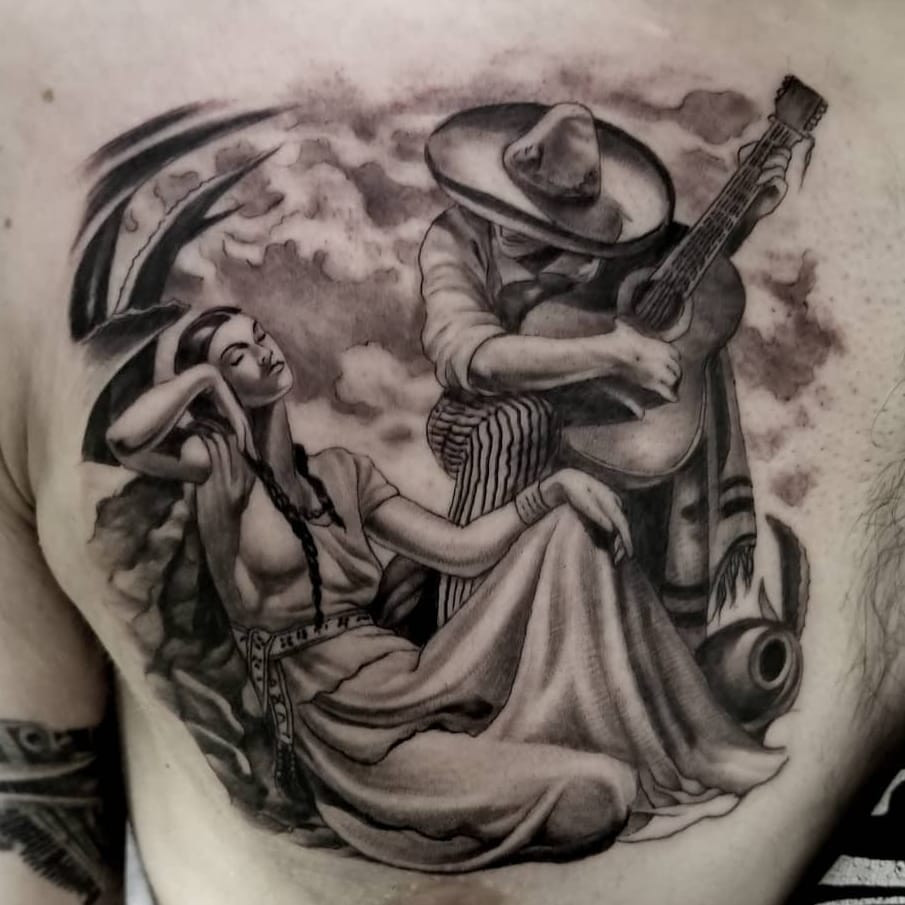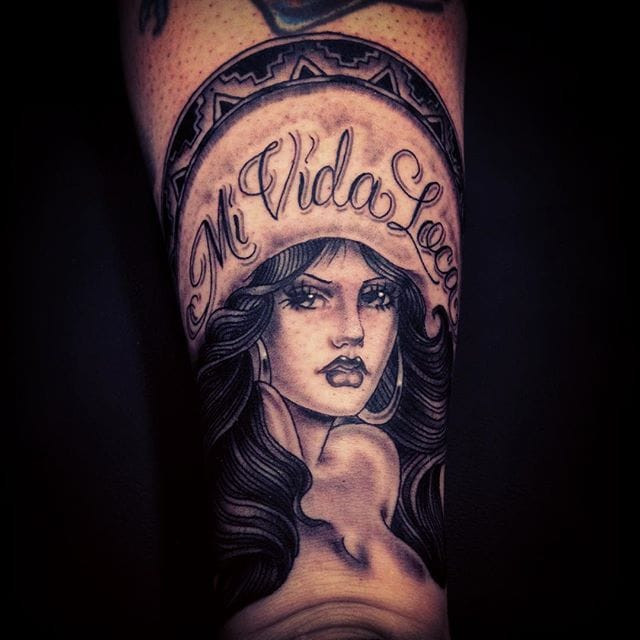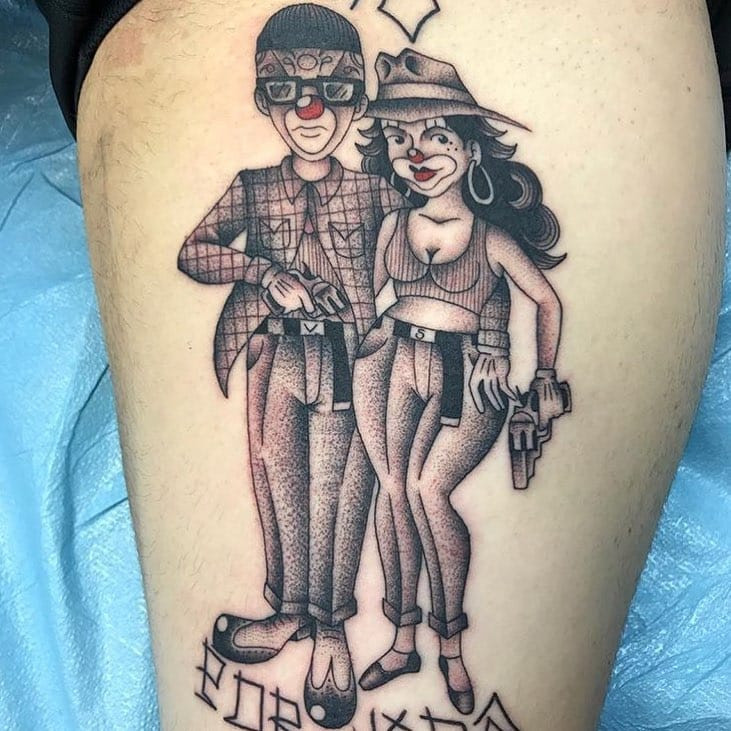Cholo Tattoos are more than just ink; they’re a powerful form of self-expression deeply rooted in Chicano culture and history. This guide by tattooat.com explores the origins, symbolism, and artistry behind Cholo tattoos, offering insights for those seeking meaningful and authentic tattoo designs. Delve into the rich heritage and artistic techniques of Cholo tattoos, and find inspiration for your next piece of body art with us.
1. What Defines Cholo Tattoos?
Cholo tattoos are defined by their deep roots in Chicano culture, often reflecting themes of family, struggle, and faith through black and gray imagery. These tattoos, popularized in Southern California, incorporate iconic symbols such as lowriders, bandanas, and religious iconography. Cholo art represents a unique blend of cultural pride and personal narrative, making it a distinctive style within the broader tattoo world, find yours today on tattooat.com.
Cholo tattoos stand as a testament to a vibrant and resilient culture. According to a study by the Chicano Studies Research Center at UCLA, Cholo tattoos serve as a visual language, communicating stories of identity and resistance. Key elements include:
- Black and Gray Realism: Reflecting the limited resources available in early prison tattooing, this style emphasizes shading and detail to create striking images.
- Cultural Symbols: Lowriders represent freedom and pride, while bandanas signify solidarity and belonging.
- Religious Iconography: Images of the Virgin Mary and other religious figures symbolize faith, protection, and remembrance of loved ones.
- Script and Lettering: Names, dates, and phrases are frequently incorporated, often in Old English or stylized fonts, to honor family and express personal beliefs.
- Payasa (Clown) Masks: These masks embody the “smile now, cry later” philosophy, reflecting the duality of joy and sorrow in life.
2. What Are the Historical Roots of Cholo Tattooing?
The historical roots of Cholo tattooing lie in the Chicano experience, evolving from prison culture and reflecting social and political struggles. Emerging in the mid-20th century, this style was heavily influenced by limited resources, resulting in the signature black and gray aesthetic. Cholo tattoos became a powerful medium for expressing identity, loyalty, and personal narratives within marginalized communities, as explored at tattooat.com.
To further understand the historical context:
- Prison Influence: The scarcity of colored inks in prisons led to the development of the black and gray style, using homemade tools and available materials.
- Pachuco Culture: The Zoot Suit Riots of the 1940s highlighted the discrimination faced by Mexican Americans, inspiring artistic expressions of resistance and cultural pride.
- Chicano Movement: The activism of the 1960s and 1970s, advocating for civil rights and cultural recognition, further solidified the role of Cholo tattoos as symbols of identity and solidarity.
- Lowrider Culture: The customization of cars became a symbol of Chicano ingenuity and self-expression, influencing tattoo designs with intricate details and personalized touches.
3. What Cultural References Appear in Cholo Tattoos?
Cultural references in Cholo tattoos include strong family ties, Catholic imagery, and symbols of street life, all reflecting the Chicano experience. These tattoos often depict lowriders, bandanas, and payasa (clown) masks, each carrying deep cultural significance. This blend of imagery creates a unique visual language that communicates stories of identity, struggle, and resilience, all explored on tattooat.com.
Expanding on the cultural references:
- Family: Names, portraits, and dates are frequently tattooed to honor family members and express the importance of familial bonds.
- Catholicism: Images of the Virgin Mary, Jesus Christ, and rosaries reflect the deep-rooted Catholic faith within Chicano communities.
- Street Culture: Symbols like dice, playing cards, and guns represent the realities of street life, including risk, loyalty, and survival.
- Lowriders: These customized cars symbolize freedom, pride, and the ability to transform something ordinary into something extraordinary.
- Payasa Masks: The “smile now, cry later” masks embody the duality of life, reflecting both joy and sorrow.
 Tattoo of a Chicano lowrider, symbolizing freedom and cultural pride
Tattoo of a Chicano lowrider, symbolizing freedom and cultural pride
4. What Iconography is Common in Cholo Tattoos?
Common iconography in Cholo tattoos includes the Virgin Mary, payasa clowns, lowriders, and script lettering, each with distinct meanings rooted in Chicano culture. The Virgin Mary symbolizes faith and protection, while payasa clowns represent the “smile now, cry later” philosophy. Lowriders signify pride and freedom, and script lettering often commemorates loved ones or expresses personal beliefs. For more insights, visit tattooat.com.
Delving deeper into the iconography:
- Virgin Mary: Represents faith, hope, and protection, often depicted in a sorrowful yet serene manner.
- Payasa Clowns: Symbolize the duality of life, balancing joy and sorrow, and the need to persevere through difficult times.
- Lowriders: Represent freedom, pride, and the ability to customize and transform one’s environment.
- Script Lettering: Used to honor family members, express personal beliefs, and commemorate important events.
- Skulls and Roses: Skulls symbolize mortality and remembrance, while roses represent beauty, love, and sacrifice.
- Praying Hands: Reflect faith, devotion, and the desire for divine intervention.
5. Who Are Some Renowned Artists Specializing in Cholo Tattoos?
Renowned artists specializing in Cholo tattoos include Freddy Negrete, Mister Cartoon, and Chuco Moreno, known for their mastery of black and gray realism and cultural symbolism. These artists have significantly influenced the style, preserving its authenticity and promoting its appreciation within the broader tattoo community. Explore their work and more at tattooat.com.
To highlight their contributions:
- Freddy Negrete: Known for his pioneering work in black and gray realism and his deep connection to the Chicano community in Los Angeles.
- Mister Cartoon: Celebrated for his intricate designs, including lowriders, script lettering, and cultural icons, with a strong following in the entertainment industry.
- Chuco Moreno: Revered for his fine-line work and detailed portraits, capturing the essence of Chicano culture with precision and artistry.
- Tamara Santibañez: Recognized for her unique blend of Chicano imagery with contemporary tattoo techniques, appealing to a diverse audience.
- Javier DeLuna: Known for his bold and striking designs, often incorporating traditional Chicano symbols with a modern twist.
 Tattoo of the Virgin Mary, a classic Cholo tattoo symbol, embodying faith and protection
Tattoo of the Virgin Mary, a classic Cholo tattoo symbol, embodying faith and protection
6. How Has Prison Culture Influenced Cholo Tattoos?
Prison culture has profoundly influenced Cholo tattoos, shaping their black and gray aesthetic due to limited resources and serving as a means of self-expression and identity within confinement. The style evolved as inmates used homemade tools and available materials to create meaningful symbols, reflecting their personal stories, loyalties, and cultural pride. Discover more about this influence at tattooat.com.
The specific ways in which prison culture shaped Cholo tattoos include:
- Black and Gray Style: The scarcity of colored inks in prisons led to the development of the signature black and gray style, emphasizing shading and detail.
- Homemade Tools: Inmates crafted tattoo machines from available materials, such as pens, batteries, and guitar strings, showcasing their ingenuity and resourcefulness.
- Symbolism of Loyalty and Identity: Tattoos became a way to express gang affiliations, honor family members, and assert personal identity within the rigid social structure of prison.
- Cultural Preservation: In a confined environment, tattoos served as a means of preserving and celebrating Chicano culture, traditions, and values.
- Storytelling: Each tattoo tells a story, reflecting the experiences, struggles, and hopes of the individual, creating a visual autobiography on the skin.
7. What Is the Significance of Black and Gray in Cholo Tattoos?
The significance of black and gray in Cholo tattoos extends beyond mere aesthetics, representing the limited resources available in prison culture and becoming a defining characteristic of the style. This monochromatic palette emphasizes detail, shading, and realism, allowing artists to create powerful and emotive images. Explore the nuances of this artistic choice at tattooat.com.
Further elaborating on the significance:
- Resourcefulness: The use of black and gray inks reflects the limited materials available in prison settings, where the style originated.
- Emphasis on Detail: The absence of color necessitates a focus on intricate linework, shading, and texture to create visually compelling designs.
- Timelessness: Black and gray tattoos have a classic and enduring quality, transcending trends and maintaining their impact over time.
- Emotional Depth: The monochromatic palette can convey a sense of solemnity, reflection, and emotional intensity, enhancing the storytelling aspect of the tattoos.
- Versatility: Black and gray tattoos can be adapted to various styles and designs, making them a versatile choice for expressing personal identity and cultural pride.
8. How Do Cholo Tattoos Reflect the Chicano Experience?
Cholo tattoos vividly reflect the Chicano experience by embodying themes of family, faith, struggle, and cultural pride. These tattoos serve as visual narratives, communicating stories of identity, resilience, and resistance within a community facing social and political challenges. Find inspiration in these stories at tattooat.com.
The Chicano experience is reflected in Cholo tattoos through:
- Family Honor: Names, portraits, and dates commemorate family members and emphasize the importance of familial bonds in Chicano culture.
- Religious Faith: Images of the Virgin Mary, Jesus Christ, and other religious figures express deep-rooted Catholic beliefs and the search for divine guidance and protection.
- Struggles and Hardships: Tattoos depicting street life, prison experiences, and personal challenges reflect the realities of life in marginalized communities.
- Cultural Pride: Symbols like lowriders, bandanas, and traditional imagery celebrate Chicano heritage and identity, asserting cultural pride in the face of discrimination.
- Resilience and Perseverance: The “smile now, cry later” philosophy, embodied in payasa masks, reflects the ability to find joy and humor amidst adversity, demonstrating resilience and perseverance.
 Tattoo of a payasa clown, embodying the "smile now, cry later" philosophy
Tattoo of a payasa clown, embodying the "smile now, cry later" philosophy
9. What Are Some Modern Interpretations of Cholo Tattoos?
Modern interpretations of Cholo tattoos blend traditional elements with contemporary techniques, expanding the style’s appeal while maintaining its cultural roots. Artists are experimenting with fine-line work, geometric patterns, and subtle color accents, creating innovative designs that resonate with a new generation. Explore these evolving styles at tattooat.com.
The modern interpretations include:
- Fine-Line Work: Artists are using ultra-thin needles to create intricate and delicate designs, adding a refined touch to traditional Cholo imagery.
- Geometric Patterns: Incorporating geometric shapes and patterns into Cholo tattoos adds a modern and abstract element, creating visually striking compositions.
- Subtle Color Accents: While maintaining the dominance of black and gray, some artists are introducing subtle color accents to highlight specific details and add depth to the designs.
- Fusion with Other Styles: Blending Cholo imagery with elements from other tattoo styles, such as realism, surrealism, and neo-traditional, creates unique and innovative designs.
- Digital Techniques: Artists are using digital tools to create complex designs and experiment with new techniques, pushing the boundaries of Cholo tattooing.
10. Where Can You Find Inspiration and Artists for Cholo Tattoos?
You can find inspiration and artists for Cholo tattoos at tattooat.com, which offers a curated collection of designs, artist portfolios, and studio listings. Additionally, tattoo conventions, social media platforms, and local tattoo shops are excellent resources for discovering talented artists specializing in this style. Start your search today and connect with the perfect artist to bring your vision to life.
For finding inspiration and artists:
- Online Platforms: Websites like tattooat.com offer extensive galleries of Cholo tattoo designs, artist portfolios, and studio listings, making it easy to find inspiration and connect with talented artists.
- Social Media: Platforms like Instagram and Pinterest are excellent resources for discovering new Cholo tattoo designs and artists, with hashtags like #cholotattoo, #chicanotattoo, and #blackandgraytattoo.
- Tattoo Conventions: Attending tattoo conventions provides the opportunity to meet artists in person, see their work up close, and get tattooed on the spot.
- Local Tattoo Shops: Visiting local tattoo shops and consulting with artists who specialize in Cholo tattoos can provide valuable insights and personalized recommendations.
- Artist Referrals: Asking for referrals from friends, family, or other tattoo enthusiasts can lead to discovering talented and reputable Cholo tattoo artists.
 Tattoo by Chuco Moreno featuring a Chicano girl, showcasing fine-line work and cultural pride
Tattoo by Chuco Moreno featuring a Chicano girl, showcasing fine-line work and cultural pride
5 Intentions of User Search
Here are five search intentions related to “cholo tattoos”:
- Design Ideas: Users are looking for inspiration and examples of Cholo tattoo designs.
- Meaning and Symbolism: Users want to understand the cultural significance and meaning behind Cholo tattoo symbols.
- Artist Discovery: Users are searching for talented tattoo artists who specialize in Cholo tattoos.
- Historical Context: Users want to learn about the origins and history of Cholo tattooing.
- Modern Interpretations: Users are interested in seeing how Cholo tattoos are evolving and being reinterpreted by contemporary artists.
FAQ About Cholo Tattoos
1. What is the origin of Cholo tattoos?
Cholo tattoos originated in the mid-20th century within Chicano communities in Southern California, particularly in prisons, reflecting cultural identity and personal narratives.
2. What are the main elements of Cholo tattoo designs?
Main elements include black and gray realism, cultural symbols like lowriders and bandanas, religious iconography, script lettering, and payasa (clown) masks.
3. What does the “smile now, cry later” tattoo mean?
The “smile now, cry later” tattoo, often depicted with payasa masks, symbolizes the duality of life, balancing joy and sorrow, and the need to persevere through difficult times.
4. Why are Cholo tattoos typically black and gray?
Cholo tattoos are typically black and gray due to the limited availability of colored inks in prisons, where the style originated, emphasizing detail and shading.
5. What is the significance of the Virgin Mary in Cholo tattoos?
The Virgin Mary in Cholo tattoos represents faith, hope, and protection, often depicted in a sorrowful yet serene manner, reflecting deep-rooted Catholic beliefs.
6. How did prison culture influence Cholo tattoos?
Prison culture influenced Cholo tattoos by shaping their black and gray aesthetic, serving as a means of self-expression and identity within confinement, and reflecting personal stories and loyalties.
7. What are some popular symbols in Cholo tattoos?
Popular symbols include lowriders, bandanas, payasa masks, script lettering, religious icons, skulls, and roses, each with distinct meanings rooted in Chicano culture.
8. How can I find a good Cholo tattoo artist?
You can find a good Cholo tattoo artist through online platforms like tattooat.com, social media, tattoo conventions, local tattoo shops, and referrals from other tattoo enthusiasts.
9. Are Cholo tattoos only for people of Chicano descent?
While Cholo tattoos are deeply rooted in Chicano culture, anyone who appreciates the style and respects its cultural significance can get one.
10. How are Cholo tattoos evolving today?
Cholo tattoos are evolving through fine-line work, geometric patterns, subtle color accents, fusion with other styles, and the use of digital techniques, expanding the style’s appeal while maintaining its cultural roots.
Explore the world of Cholo tattoos at tattooat.com and discover the perfect design and artist to express your unique story and appreciation for this rich cultural art form. Visit us at 1825 SW Broadway, Portland, OR 97201, United States or call +1 (503) 725-3000.
